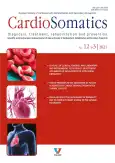Characteristics of clinical signs, laboratory and instrumental examinations in various mechanisms of development of type 2 myocardial infarction
- Authors: Oblavatckii D.V.1, Boldueva S.A.1
-
Affiliations:
- Mechnikov North-Western State Medical University
- Issue: Vol 12, No 3 (2021)
- Pages: 132-138
- Section: Original study articles
- URL: https://journals.rcsi.science/2221-7185/article/view/83282
- DOI: https://doi.org/10.17816/22217185.2021.3.201042
- ID: 83282
Cite item
Full Text
Abstract
Aim. To identify different pathogenetic variants of myocardial infarction type 2 (MI-2).
Material and methods. Reviewed 4168 cases of MI admitted in multidisciplinary hospital for 10 years. 353 patients met the criteria for MI-2 without signs of coronary atherothrombosis (CA). In the study group, the features of clinical and laboratory-instrumental manifestations were evaluated.
Results. Cases of IM-2 were subdivided into 4 clinical-pathogenic variants (CPV): 1-CPV developed due an increasing in myocardial oxygen demand; 2-CPV, arising from a decrease in the supply of oxygen; 3-CPV associated with local coronary circulation disorder; 4-CPV developed due to the combined oxygen-energy imbalance. In 72 (20.4%) cases, 1-CPV was detected, caused by a hypertensive crisis and/or tachyarrhythmias; 2-CPV observed in 73 (20.68%) patients with hypotension, anemia, microvascular dysfunction, respiratory failure; 3-CPV caused by spasm and embolism of CA was detected in 47 (13.31%) cases; in 161 (45.61%) patients, IM-2 is associated with increased myocardial oxygen demand with reduced oxygen delivery. The gender and risk factors in groups are comparable. The average age of 1-CPV- and 3-CPV-patients was less and amounted to 65.7 and 56.5 versus 70.2 and 73.8 years in the 2-CPV and 4-CPV. Typical clinical and laboratory-instrumental signs of MI were common for patients with 1-CPV and 3-CPV, while 2-CPV and 4-CPV more often had chronic severe pathology, multivessel coronary disorder, and the clinical presentation and ischemic signs were less common.
Conclusion. Clinical manifestations and results of examination of patients with MI-2 depend on the mechanism of its development.
Full Text
##article.viewOnOriginalSite##About the authors
Dmitrii V. Oblavatckii
Mechnikov North-Western State Medical University
Author for correspondence.
Email: dimi1987@yandex.ru
ORCID iD: 0000-0003-1628-0193
Graduate Student
Russian Federation, Saint PetersburgSvetlana A. Boldueva
Mechnikov North-Western State Medical University
Email: dimi1987@yandex.ru
ORCID iD: 0000-0002-1898-084X
D. Sci. (Med.), Prof., Mechnikov North-Western State Medical University
Russian Federation, Saint PetersburgReferences
- Radovanovic D, Pilgrim T, Seifert B, et al. Type 2 myocardial infarction: incidence, presentation, treatment and outcome in routine clinical practice. J Cardiovasc Med. 2017;18(5):341-7.doi: 10.2459/JCM.0000000000000504
- Sandoval Y, Thygesen K. Myocardial Infarction Type 2 and Myocardial Injury. Clin Chem. 2017;63(1):101-7. doi: 10.1373/clinchem.2016.255521
- Thygesen K, Jaffe AS, Chaitman BR, et al. Fourth Universal Definition of Myocardial Infarction. Eur Heart J. 2019;40(3):237-69. doi: 10.1093/eurheartj/ehy46
- Аверков О.В., Барбараш О.Л., Бойцов С.А., и др. Дифференцированный подход в диагностике, формулировке диагноза, ведении больных и статистическом учете инфаркта миокарда 2 типа. Рос. кардиол. журн. 2019;24(6):7-21 [Averkov OV, Barbarash OL, Boytsov SA, et al. Differentiated approach to diagnosis, formulation of the diagnosis, case management and statistical accounting of type 2 myocardial infarction. Russian journal of cardiology. 2019;24(6):7-21 (in Russian)]. doi: 10.15829/1560-4071-2019-6-7-21
- Болдуева С.А., Леонова И.А. Первичная микроваскулярная стенокардия (кардиальный синдром Х): клинические проявления, прогноз, диагностика, лечение. Сердце. 2016;5(91):307-19 [Boldueva SA, Leonova IA. Primary microvascular angina (cardiac syndrome X): clinical manifestations, prognosis, diagnosis, treatment. Heart. 2016;5(91):307-19 (in Russian)]. doi: 10.18087/rhj.2016.5.2199
- McCarthy CP, Vaduganathan M, Januzzi JL. Type 2 Myocardial Infarction – Diagnosis, Prognosis, and Treatment. JAMA. 2018;320(5):433-4. doi: 10.1001/jama.2018.7125
- Neumann JT, Sörensen NA, Rübsamen N, et al. Discrimination of patients with type 2 myocardial infarction. Eur Heart J. 2017;38(47):3514-20.
- Baron T, Hambraeus K, Sundström J, et al. Type 2 myocardial infarction in clinical practice. Heart. 2015;101:101-6. doi: 10.1136/heartjnl-2014-306093
- Облавацкий Д.В., Болдуева С.А., Соловьева М.В., и др. Распространенность инфаркта миокарда 2-го типа в структуре летальности по данным многопрофильного стационара за 7 лет. Кардиология. 2020;60(6):76-83 [Oblavatsky DV, Boldueva SA, Solovieva MV, et al. Prevalence of type 2 myocardial infarction in the structure of mortality according to the data of a multidisciplinary hospital for 7 years. Cardiology. 2020;60(6):76-83 (in Russian)]. doi: 10.18087/cardio.2020.6.n896
- Chapman AR, Shah ASV, Lee KK. Long-term outcomes in patients with type 2 myocardial infarction and myocardial injury. Circulation. 2018;137(12):1236-45. doi: 10.1161/circulationaha.117.031806
- Lambrecht S, Sarkisian L, Saaby L, et al. Different Causes of Death in Patients with Myocardial Infarction Type 1, Type 2, and Myocardial Injury. Am J Med. 2018;131(5):548-54.
- Cediel G, Gonzalez-Del-Hoyo M, Carrasquer A, et al. Outcomes with type 2 myocardial infarction compared with non-ischaemic myocardial injury. Heart. 2017;103(8):616-22.
Supplementary files











